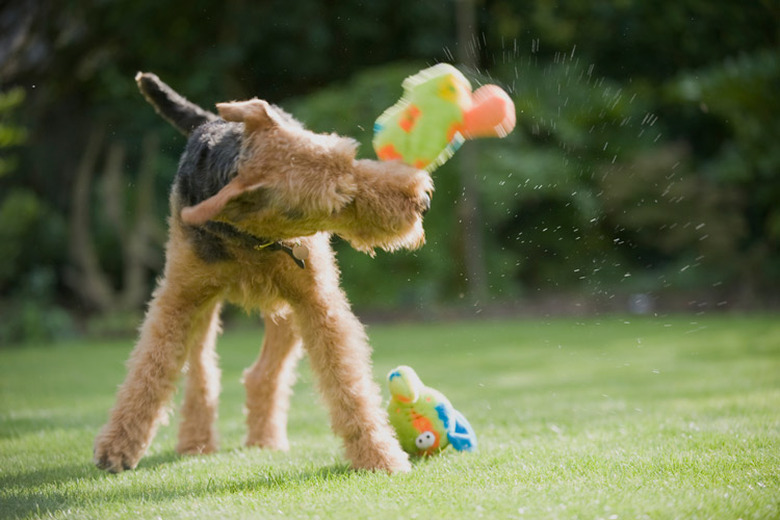Why Do Dogs Shake Their Toys?
Chasing and tugging at toys is instinctual behavior for most dogs, but so is shaking them. This is not a gentle maraca-type shake, but a powerful whipping action that gets your dog's entire upper body involved. The history of this behavior is traced back to your pup's ancestors who had to hunt to survive.
Hunting
Hunting
When your pooch shakes his toy, it mimics the action wolves and other wild canines use to kill small prey. The shaking action is designed to instantly snap the prey's back or neck. Your pup might be a sweet, cuddly ball of fur, but he still retains those basic instincts and the need to "attack" his toys on occasion. Get him toys that match the size of his likely prey. For example, a small dog might need a mouse-sized shakeable toy, while a large breed might need something more duck-sized.
Playing
Playing
Even though his roots lie in hunting for survival, your dog probably likes to shake his toys because it's fun. When he's ready for you to play, don't be surprised if he grabs a toy, dives in front of you and shakes it vigorously. It's his way of saying, "Look at me! Play with me!" He might also shake a toy that you've just thrown for him to fetch as he runs back to you, adding another element to your game. If you stop a game of tug before he's finished playing, he might think shaking it can taunt you back into another round.
Frustration
Frustration
Dogs also shake toys with the intent of destroying them, usually out of boredom or frustration. This is most common in dogs left alone for long periods of time or those with severe separation anxiety, according to the ASPCA. This could mean you walk into a huge mess when you get home from work, with fluffy toy stuffing scattered around your home. The main problem with the behavior — besides the mess, of course — is that your pooch is unlikely to stop with just toys. Desperate for your attention, even negative attention, he could move onto your blankets, pillows or nicknacks. Giving him lots of attention and exercise can help, as can puzzle toys or chew bones to keep him busy while you're gone.
Aggression
Aggression
Most dogs shake toys only when they play, but some use it to show aggression. Pay close attention to your dog's posture when he shakes a toy. If he's bounding around in a playful manner or lowering his upper body as he's shaking, he's out for a bit of fun. However, if he is jumping up slightly, raising his head or shaking a toy over you or a smaller animal, the behavior might be aggressive. This can lead to him biting and shaking smaller pets or even young children, so it's important to stop aggressive shaking behavior. Work with your veterinarian or an animal behaviorist to create a plan to stop the behavior, which might include removing your attention when he takes an aggressive stance, rewards for proper behavior and appropriate punishments for aggressive behavior.
References
Humane Society of the United States: Dog Toys
ASPCA: Destructive Chewing
ASPCA: Aggression in Dogs
About the Author
While studying journalism in the Army and at the University of Missouri, Rob Harris developed a lifelong love of physical fitness and nutrition, contributing often to a dairy industry newsletter. He has also worked with and created blogs for several family businesses including a professional dog kennel and a flower shop, where he used his experience as an avid gardener to grow plants for sale.
